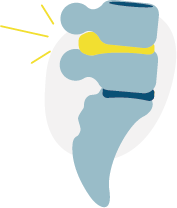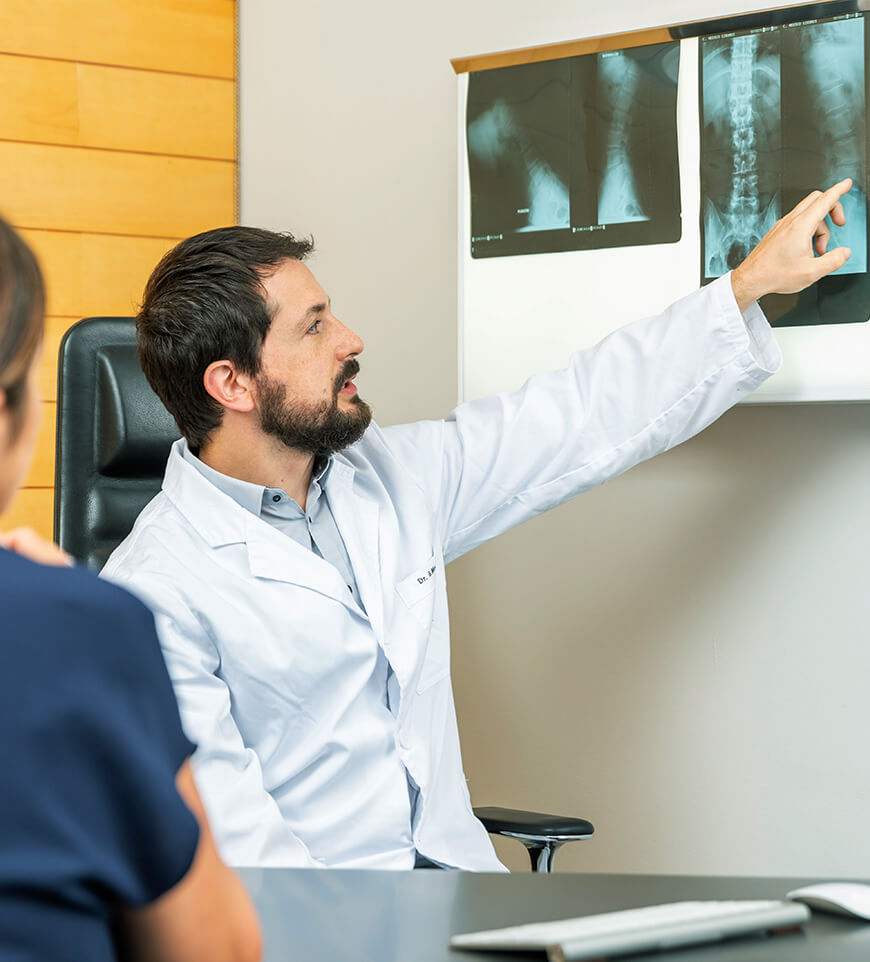A hernia is the protrusion of any organ or tissue out of its usual place. In the case of lumbar disc herniation, it occurs when a degenerated intervertebral disc ruptures and its contents are extended beyond the edges of the disc.
Acabar con el dolor es posible y nuestro equipo quiere ayudarle a conseguirlo. Dé el primer paso contactando con nosotros.
Madrid: +34 919 148 441
Barcelona: +34 936 090 777
Llevamos la excelencia neuroquirúrgica a Sevilla, ofreciendo servicios especializados en neurocirugía de columna y cráneo.
¡Llama al +34 955 277 751 o +34 633 143 686 para más información!
A hernia is the protrusion of any organ or tissue out of its usual place. In the case of lumbar disc herniation, it occurs when a degenerated intervertebral disc ruptures and its contents are extended beyond the edges of the disc.

Usually, it is the innermost and softest part of the disc, called the nucleus pulposus, which expels material through the tear in the external fibrous ring. The location and extent of the tear in said ring and the volume of the material expelled from the nucleus will determine what symptoms are caused.
A herniated disc can be asymptomatic, or cause only local lumbar pain, or, if it occupies space where the nerve roots of the lumbar spine run, it can press on these nerves and cause pain, weakness, or numbness in the legs or buttocks.
In most cases, herniated discs are caused by natural wear and tear of the disc, called disc degeneration. In other words, as the years go by, the discs are less flexible and, therefore, more prone to damage.
The lumbar area is subjected to body weight practically continuously, so it is common that over the course of the day, this area becomes sore due to inadequate postures, movements or carrying excess weight. Injuries of this type are one of the most frequent back problems.
The specific causes cannot always be discovered, as they may be the result of a combination of several factors. However, in most cases they are due to poor postural habits. There are also certain risk factors for developing a herniated disc:
To disc herniation.
People with jobs that require physical exertion and strenuous movement are more prone to disc hernia.
Can overload the discs and encourage their degeneration, especially the lumbar discs.
Is related to a lower oxygen supply to the disc, which favors its deterioration.
Can also cause a lumbar disc hernia, although this is less frequent.

All things considered, whether or not someone has is a genetic risk factor, taking care of posture, exercising to keep muscles strong, trying to maintain a healthy weight and avoiding tobacco can be very effective in preventing disc herniation.
It usually occurs when making certain movements or standing in certain positions, and calms down when stretched out at rest. However, if the compression is severe, there may be very little relief even lying down. Depending on the location of the herniated disc and which nerve root it affects, pain may appear in different areas of the legs or low back.
The muscles around the lumbar hernia tend to weaken, which can cause problems like stumbling or lack of balance. In case of acute onset and inability to move the foot or leg, this is a medical emergency and should be consulted promptly.
The hernia can cause numbness or tingling that radiates from the affected nerves to the muscles. In this case, affecting the lower extremities, the legs.
Magnetic resonance imaging (MRI) is the most widely used test for the diagnosis of herniated disc. This allows us to identify herniated discs and their characteristics, as well as to observe whether there is nerve root compression caused by the lumbar disc herniation.
Computed tomography (CT) scans can also help diagnose this condition, but they do not give as sharp an image in this case.
However, it is important to clarify that the majority of hernias seen on imaging tests are not symptomatic and that many cases of low back pain that appear to be lumbar or sciatica pain do not originate from hernias. For this reason, it is essential to have the evaluation of a specialist, who will contrast the symptoms, their evolution and a physical examination, with the images to determine whether the patient's problem derives from what is seen in the images or not. In addition, if there are several hernias, the specialist will be able to determine which one is causing the symptoms.
At Instituto Clavel, once a correct diagnosis has been made, we will recommend the appropriate treatment that will give the patient the best results. Taking into account the patient’s condition, the probable evolution of the condition under each of the different treatment options, and which types of treatment are feasible depending on the individual characteristics of each patient.
In all cases, the specialist may recommend treating the symptoms with medication. In this case the function, purpose, and any possible side effects of the medication will be thoroughly explained. The treatments for lumbar disc herniation are divided into three main groups, described below.
This is usually the initial treatment protocol. It includes pain relievers, anti-inflammatories, muscle relaxants and neuroleptic drugs. To improve their effectiveness it is necessary to combine them with physical therapy and exercise.
Virtually all cases of lumbar disc herniation require rehabilitation treatment for the muscles and nerves, as well as postural reeducation, either on its own, or as a complementary treatment. Our physiotherapists and osteopaths at IC Rehabilitation are experts in managing spinal problems, and they will offer you personalized treatment, instead of standard passive treatments that do not take into account the patient's age, daily activity or requirements to return to a normal life.
In fact, the majority of new cases can be treated conservatively, and part of the treatment includes teaching correct posture and preventive measures to avoid relapses.
A key preventive measure is to change harmful daily habits that can cause pain, such as lifting heavy objects or using certain postures. If applying these methods for one or two months does not achieve the expected results, at Instituto Clavel we evaluate other surgical procedures to reduce episodes of pain.
For cases of moderate severity, or those where surgery is not contemplated due to individual patient factors, we may propose blocking or infiltration-type treatments at the level of the lumbar spine to treat pain radiating to the legs.
When lumbar pain is limited to one area of the low back, it is possible to opt for treatments such as infiltrations or facet rhizolysis by pulsed or thermal radiofrequency. These treatments are performed in the operating room, but with local anesthesia as an outpatient service (the patient does not need to be admitted to the hospital). Sometimes this will be the only treatment necessary, and in others it will work as a step prior to surgery.
When there are no improvements with conservative treatments, or the severity of the pain or affectation of muscle strength is disabling, we may propose surgical treatment.
Whenever possible, we will try to resolve nerve compression in the least invasive way, so in most cases we will opt for simple lumbar microdiscectomy, which consists of removing the hernia tissue and, depending on the case, the partial emptying of the affected disc.
In some cases we will consider instrumented surgery: cases where the hernia reproduces, very wide-based hernias with bilateral root compression, or associated with other pathologies that require it. This surgery could be an artificial disc replacement (ADR) or, in cases where there are other damaged spinal elements, arthrodesis or fusion.
The evolution of the herniated disc depends on what stage it is at and the treatment chosen. At Instituto Clavel we are committed to personalized treatment combined with the most cutting-edge technology to carry out the appropriate treatments to help patients recover their well-being and improve their quality of life.
In addition, we make sure that the patient feels accompanied and well-informed throughout the recovery process, to guarantee the best results.
Any of the specialists in Neurosurgery and Orthopedic Surgery at Instituto Clavel can make an excellent assessment of your case and recommend the most appropriate treatment.
Our team, with some of the greatest specialists in this field at both the national and international level, and the latest technology, is prepared to make a correct diagnosis of lumbar disc herniation, and recommend the treatment that will offer the patient the best results.
This way, if the patient needs surgical treatment, the same doctor will recommend the optimal technique for their problem. If the conservative option is better, we will be able to refer you to our specialist in pain procedures, and to our team of specialists in physical rehabilitation of the spine IC Rehabilitation.
Contact us so that we can give you a personalized assessment.